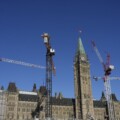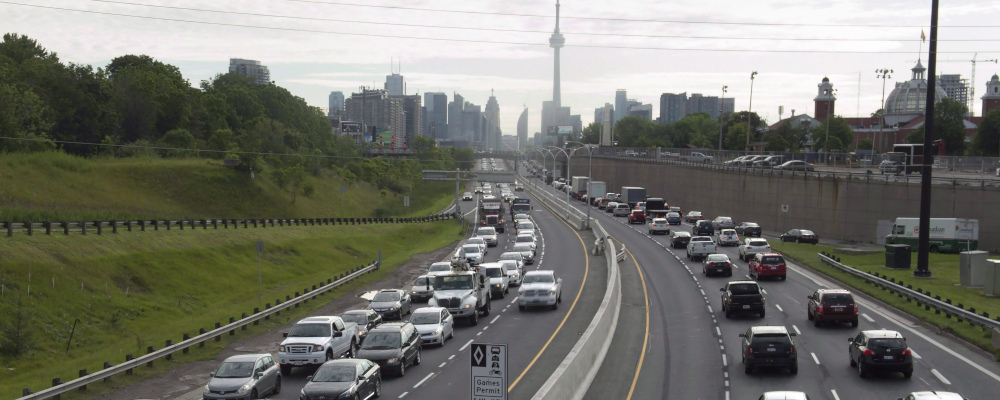The price of transportation in Ontario is too high. Or at least that seems to be the political consensus. All three of the major parties are fixated on reducing the price of transportation in Ontario. While they defer on which prices to prioritize—the Liberals made a high-profile election pledge to slash transit fares while the Ford government recently rolled back road tolls—they all seem to agree that the price of getting around is too high. The trouble is that low prices don’t eliminate costs. We just pay for them through time, frustration, and taxes. There is no such thing as a free ride.
There’s an old saying, popularized by science fiction author Robert Heinlein: “there ain’t no such thing as a free lunch”. While it has been in popular usage for more than a half-century, it’s a hard concept to internalize. The fundamental problem is that we often conflate prices and costs.
It’s not that hard to enjoy a lazy day off without spending any money. You can get in your car, drive to a park, walk around, drink from a public water fountain, sit on a bench, and go home without spending a dollar (as long as you have gas in the tank). But not spending money on this trip doesn’t make it free. Money was spent building the road and parks. More money will be spent maintaining them. And by getting on the road, parking, and walking through the park, you are in a small way reducing other peoples’ ability to enjoy the roads and parks. But it’s free, so why not?
Except, it’s not free. We pay for these services through our taxes, whether we use them or not. Property taxes fund the local governments that build and maintain most roads and transit systems; gas taxes help fund infrastructure; we pay for free municipal parking indirectly by foregoing government revenue; in large urban areas, we pay for traffic congestion and transit crowding with our time. So even if there is no price, there are costs.
Providing services free of charge and sorting it out through the tax system means that people will pay the same amount for transportation whether they use it or not. And with no price mechanism to ration the amount of time we spend on the road (and when), some people will drive more than they would if they faced an up-front cost. At the margins, this can make life worse for everyone.
Consider, for instance, a freelance writer. This person doesn’t have a fixed schedule, so they can do their errands whenever they like. In a system where transportation isn’t guided by prices, this person is a menace. They can do errands when the roads are busy, but the stores are not. Or maybe they’ll hop on a packed streetcar to save 10 minutes of walking to get groceries. This is just one person. But there are millions of people out there with their own idiosyncratic schedules and preferences. And without strong incentives to avoid rush hour when they can, many won’t.
Prices can help solve these coordination problems. We can use road tolls and congestion pricingCongestion Pricing: Q&A https://www.its.ucla.edu/news/for-the-press/congestion-pricing/ to dissuade people from cramming into rush hour traffic unless it’s necessary. We can have distanced-based, variable pricing for public transit to dissuade people from taking long trips at busy times unless they need to. And we can let the market set parking prices, rather than making it artificially cheap or free through public policy.
This might not seem like an appealing vision. Especially at a time when inflation is at a multi-decade high and people are reluctantly heading back to their offices. The alternative is less appealing. The Texas Transportation Institute estimated that traffic congestion cost the American economy $190 billion through delays and wasted fuel in 2019.2021 Urban Mobility Report https://static.tti.tamu.edu/tti.tamu.edu/documents/mobility-report-2021.pdf The average commuter endured 54 hours of traffic delays that year. Even during the height of the pandemic in 2020, congestion cost the American economy $101 billion. Despite widespread COVID restrictions, commuters still lost 27 hours to traffic congestion on average that year. Closer to home, the Toronto Region Board of Trade has estimated that the cost of congestion in the Toronto region alone was $6 billion in 2013, and could hit $15 billion dollars by 2031.A Green Light To Moving The Toronto Region: Paying For Public Transportation Expansion https://www.bot.com/portals/0/unsecure/advocacy/DiscussionPaper_AGreenLight_March18_2013.pdf So while paying for transportation through user fees might seem bad, the alternative isn’t exactly utopian.
Of course, we could just try to build our way out of traffic congestion and overcrowded public transportation, right? Unfortunately, just building more capacity is at best a partial fix. In their seminal work on traffic congestion, “The Fundamental Law of Road Congestion”, Gilles Duranton and Matthew Turner gave a blunt assessment of the notion that we can build our way out of congestion: “people drive more when the stock of roads in their city increases.”The Fundamental Law of Road Congestion: Evidence from US Cities https://www.aeaweb.org/articles?id=10.1257/aer.101.6.2616 They estimate that a one percent expansion of highway capacity leads to a one percent increase in vehicle kilometres travelled. While it is possible that we need more roads and transit lines to service particular areas, the evidence suggests that just building more capacity won’t tackle crowding and congestion. That goes for public transportation and well as highways.
This brings us to Queen’s Park. Despite the GTA’s notorious gridlock, none of the three major parties seem interested in tackling traffic congestion. To his credit, Toronto Mayor John Tory did try to expand the use of road tolls in Toronto. But that got shot down by Premier Wynne and buried by Premier Ford (who also removed existing tolls from two highways). Rather than pricing existing roads, Ford has pledged to plow forward with a new $6 billion highway that would connect Highway 401 from Milton to Highway 400 in Vaughan, allowing some drivers to bypass Toronto. It’s being billed as a tool to combat traffic congestion. But without tolls, any reprieve is likely to be temporary.
While the PCs are focused on the price of driving, the Liberals and NDP tend to focus more on the price of public transportation. While it is seemingly easier to justify since lower-income workers often rely on public transportation, not all public transportation trips are borne of necessity. For instance, the Ontario Liberal Party’s Buck-a-Ride pitch specifically mentioned that people coming into the city from Oakville to watch a baseball game would save nearly $20. While this was sold as a benefit, it is actually a downside. There is no compelling public policy rationale for subsidizing long discretionary trips.
If we want to help low-income commuters, we should target them directly (discounted transit passes already exist in Toronto, for instance). Broad subsidies get vacuumed up by everyone and create bad incentives. Asking commuters to pay a higher share of transportation costs would lead to more government revenue that could be used for other priorities which can include making lower-income commuters whole. It can also allow governments to reduce taxes or pay to maintain and improve roads and transit. This would be more efficient and more equitable.
Rather than reducing the sticker price of transportation, we should be looking at ways to internalize the cost of getting around. Charge the full price and let markets sort it out. And lest the poor be left behind, we can use some of that newfound revenue to subsidize low-income people directly. There may be no such thing as a free ride, but we can choose to pay for some people’s rides rather than continuing our equal sharing of commuting misery.
Recommended for You

The Notebook by Theo Argitis: Carney’s One Big Beautiful Tax Cut, and fresh budget lessons from the U.K.

Christopher Snook: Is Canada sleepwalking into dystopia?

Rudyard Griffiths and Sean Speer: The fiscal hangover from the One Big Beautiful Bill hits Canada

‘A fiscal headache for Mark Carney’: The Roundtable on how Trump’s One Big Beautiful Bill could affect Canada



